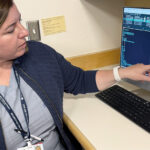Embracing the benefits of virtual visits during the COVID-19 pandemic

Sheltering at home during the coronavirus doesn’t mean you have to sacrifice high-quality health care. Many families are finding that a lot of services they used to travel into Boston for are now available from the comfort of home using our expanded telehealth capacity. This is allowing parents and kids to manage chronic conditions, or have new symptoms diagnosed and treated, using a smart phone or computer screen.
Relying on expanded telehealth visits
At Boston Children’s, virtual visits have gone from 20 to 40 per day before the coronavirus to as many as 1,400 to 1,800 per day as of late April. Exactly how the visits work depends on your child’s provider and health needs. Each specialty has its own way to replicate in-person visits remotely. But there’s one common theme that most remote visits share: Parents and other caregivers can play an essential role in helping clinicians get the information they need.
Saving time with a remote visit
During a recent virtual visit, a child was diagnosed with a complicated inguinal hernia and sent to Boston Children’s for urgent evaluation and surgery. Surgeon Dr. Alex Cuenca says that he worked as a team with the parents right over the computer screen.
“I drew a diagram and showed them the direction to push the child’s bulge [from the hernia],” he explains. “I could see the bulge wasn’t reducing and I looked at the child to see how he was reacting.” This information prompted him to send the child with the hernia to his colleague, Dr. Thomas Hamilton, assistant program director of the Pediatric Surgery Fellowship, to operate.
By having the diagnosis already, the boy was fast-tracked in the emergency room and quickly moved into the operating suite, minimizing his exposure to germs and reducing stress for his family.
Avoiding return visits
In the Orthopedic and Sports Medicine Center, parents or caregivers are also an essential part of remote visits in the absence of a clinician being able to conduct a hands-on physical examination. Dr. Donald Bae, clinical chief of Orthopedic Surgery, says that in order to make virtual visits effective, he often relies on parents to serve as “an extension of [his] arm,” touching the patient and moving limbs so he can assess range of motion and pain levels remotely.
He points out that he and his colleagues are also finding other creative ways to avoid unnecessary clinic visits without sacrificing the quality of care. “I did two operations yesterday where I would normally have applied a cast that requires a return visit to remove,” Dr. Bae says. “Instead, I used a splint that could be removed at home during a virtual visit so the patients won’t have to come back to the hospital.”
Using health history instead of a physical exam
In the Division of Gynecology, health records can provide important information about patients’ health status, physical symptoms, and concerns when a genital or pelvic exam can’t be performed, says Dr. Frances Grimstad. She points out that she and her colleagues are relying more heavily on this health history to understand their patients and determine how best to treat symptoms.
For people who require injections, such as the contraceptive Depo-Provera, Dr. Grimstad says that she has been able to use virtual visits to teach patients or family members how to administer these injections at home, guiding them over the video screen.
Coupling lab results with the virtual exam
For transplant patients, virtual visits typically involve a whole team of providers involved in one appointment. Many patients find knowing in advance who will be on the call, and what to expect, can help things go smoothly and keep them from feeling overwhelmed. “We call or email them the day before so they know what we will be doing and we can set expectations,” says JoAnn Morey, kidney transplant coordinator for the Pediatric Transplant Center.
In addition, transplant patients typically need to get blood work done before the call. The lab results, coupled with the remote physical exam, give providers important information about how kids are doing. “We see patients up close [on the screen], such as to check a lip ulcer, and can ask them to take their blood pressure or provide a blood pressure log,” Morey says. The combination of information allows patients and providers to work together in the most effective way.
Helping with social distancing
Keep in mind that telehealth does not replace the need for all in-person visits, but it does minimize the number of patients and staff members who need to be on site at any one time. Making diagnoses remotely can also minimize the time on site for patients who do need to come in person for a visit or a surgery.
Many families find that virtual visits are saving them time, saving them money, and giving them peace of mind during this challenging time.
Get more answers about Boston Children’s response to COVID-19 and learn about our virtual visits.
Related Posts :
-

Ask a sports medicine specialist: Why are ACL tears so common among female athletes?
When an athlete is sprinting after an opponent who suddenly stops or changes direction, their anterior cruciate ligaments (ACLs) make ...
-

Forging a path back to school after orthopedic trauma
Orthopedic trauma can force children to miss school, sometimes for an extended period. But even when patients have regained enough ...
-

Jackie’s dreams of playing professional soccer back on track after ACL surgery
From her dorm in Newcastle, England, Jackie Zapata can hear fans roaring in the soccer stadium a few blocks away. ...
-

Understanding and treating Mason’s congenital nevus
Kim and Ryan noticed their son’s birthmark almost immediately after he was born. They knew birthmarks were common, but ...





